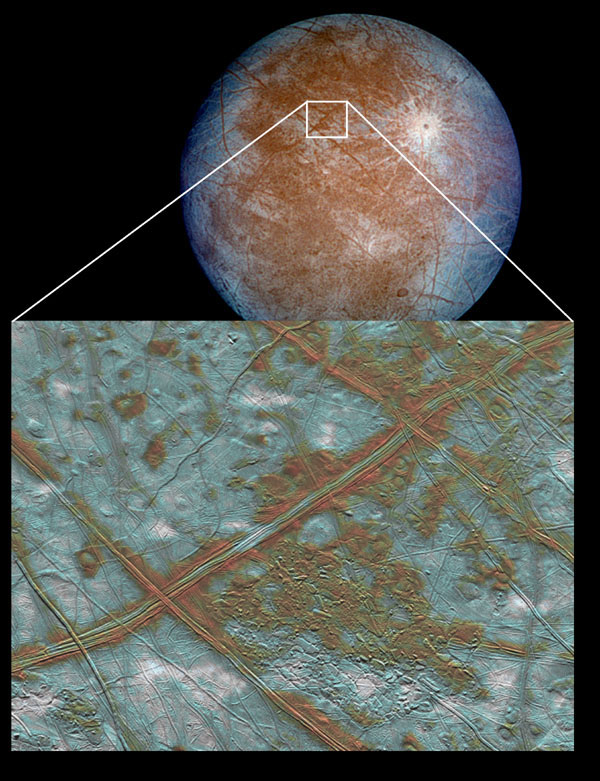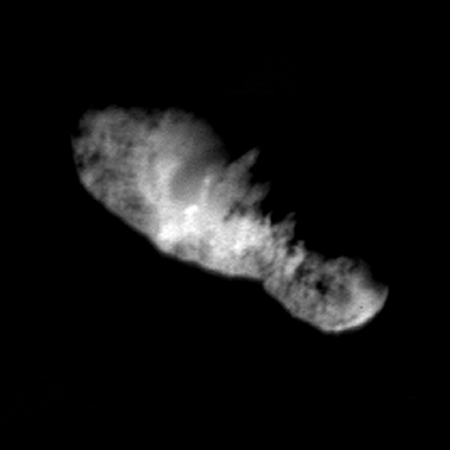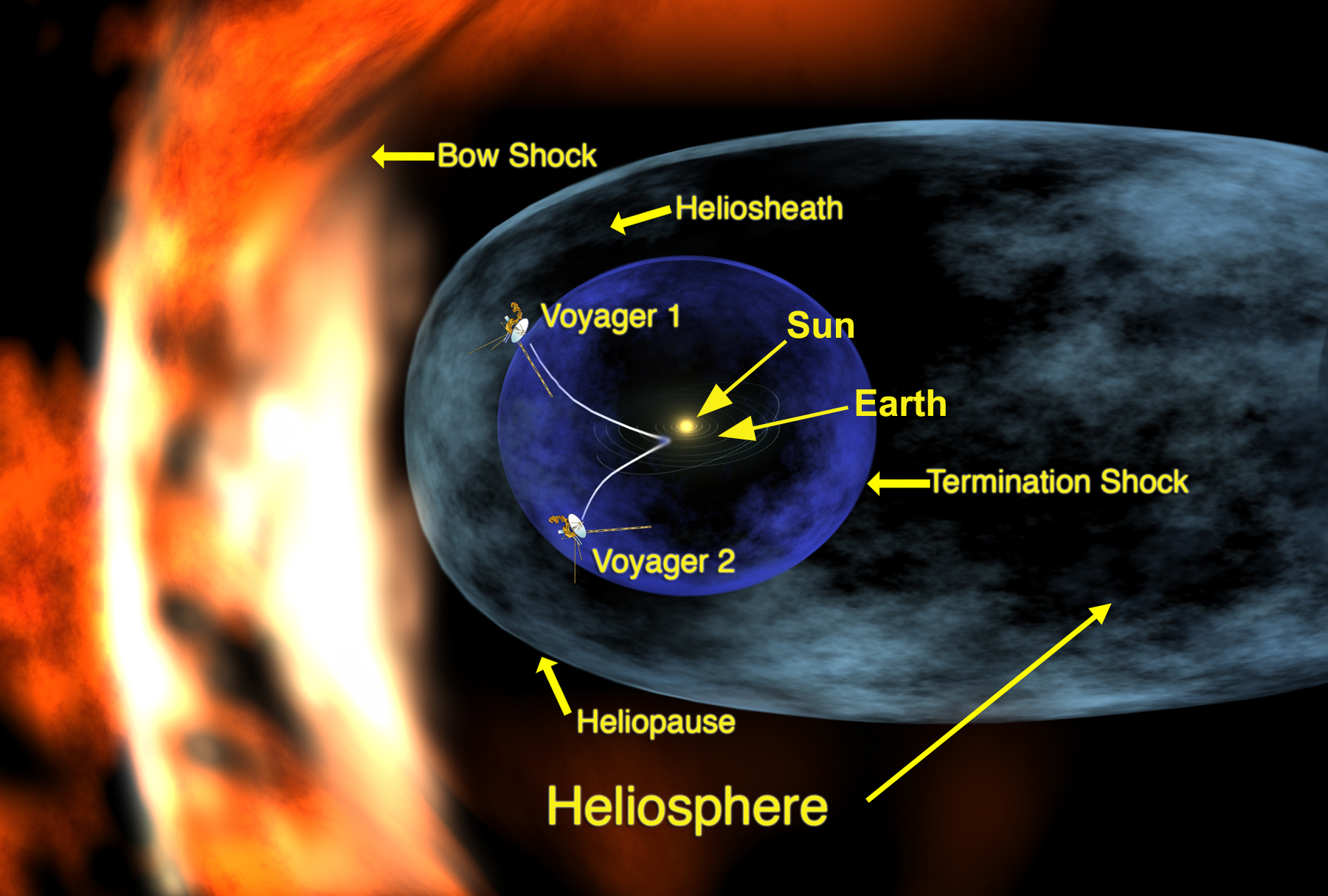Next Launch
Total Students
2,609
Total Launches
683
Eggs Survived
418 61.2%
Rockets Survived
536 78.5%
Aug. 1, 2003
In Search of Alien Oceans
by Patrick L. Barry and Dr. Tony Phillips
A robotic submarine plunges into the dark ocean of a distant world,
beaming back humanity's first views from an alien ocean. The craft's
floodlights pierce the silty water, searching for the first, historic
sign of extraterrestrial life.
Such a scenario may not be as fantastic as it sounds. Many scientists
believe that Jupiter's moon Europa conceals a vast ocean under its
icy crust. If so, heat from the moon's interior-which would keep the
ocean from freezing solid-may also drive subaquatic volcanoes and
hydrothermal vents. On Earth, such deep-sea vents provide chemical
energy for ecosystems that thrive without sunlight, and some
scientists even suggest that Earthly life first got started around
these vents.
So a warm Europan ocean spotted with thermal vents could be a natural
incubator for life. That's why some scientists hope that someday we
will send a probe to Europa that could bore through the ice and
explore the ocean below like a submarine.
To plan for such a mission, scientists would first need to put a
camera in orbit around Europa. By looking for places where water has
welled up to fill the spindly cracks that riddle Europa's surface,
scientists can estimate where the ice is thinnest-and thus easiest to
bore through.
That mission scenario presents a problem, though. Europa orbits
Jupiter inside the giant planet's punishing radiation belts.
Continuous exposure to such high radiation would damage today's
scientific cameras, making the information they gather less reliable
and perhaps ruining them completely.
That's why NASA is designing a more radiation-tolerant CCD that could
be used on a mapping mission to Europa. A CCD (short for
"charge-coupled device") is a digital camera's chip-like core, which
converts light into electric signals.
"We've seen the effects of this radiation during the Galileo mission
to Jupiter," says JPL's Andy Collins, principal investigator for the
Planetary Imager Project. "Galileo has orbited Jupiter for many
years, dipping inside the radiation belts only for brief intervals.
Even so," he says, "we've seen clear signs of damage to its
instruments."
By using the hardier CCD's developed by the Planetary Imager Project,
a future probe could remain in Jupiter's radiation belts for many
months, gathering the maps scientists will need to finally get a peek
behind Europa's icy veil. And who knows, maybe there will be
something peeking back!
To learn more about the Galileo mission to the Jupiter system, visit
http://www.jpl.nasa.gov/galileo/. For children, a fun, interactive
"Pixel This!" game at
http://spaceplace.nasa.gov/p_imager/pixel_this.htm introduces CCDs
and how a really tough one will be needed for a future mission to
Europa.
This article was provided by the Jet Propulsion Laboratory, California Institute of Technology, under a contract with the National Aeronautics and Space Administration.
 Cracks on the icy surface of Jupiter's moon Europa give evidence of a liquid ocean below.
Cracks on the icy surface of Jupiter's moon Europa give evidence of a liquid ocean below.
Sept. 1, 2003
Careful Planning and Quick Improvisation Succeed in Space Biz
by Dr. Tony Phillips
On December 18, 2001, ground controllers at JPL commanded NASA's Deep Space 1 (DS1) spacecraft to go to sleep. "It was a bittersweet moment," recalls Marc Rayman, the DS1 project manager. Everyone was exhausted, including Deep Space 1, which for three years had taken Rayman and his team on the ride of their lives.
DS1 blasted off atop a Delta rocket in 1998. Most spacecraft are built from tried-and-true technology-otherwise mission controllers won't let them off the ground. But Deep Space 1 was different. Its mission was to test 12 advanced technologies. Among them: an experimental ion engine, a solar array that focused sunlight for extra power, and an autopilot with artificial intelligence. "There was a good chance DS1 wouldn't work at all; there were so many untried systems," recalls Rayman.
Nevertheless, all 12 technologies worked; the mission was a big success.
Indeed, DS1 worked so well that in 1999 NASA approved an extended mission, which Rayman and colleagues had dreamed up long before DS1 left Earth-a visit to a comet. "We were thrilled," says Rayman.
And that's when disaster struck. DS1's orientation system failed. The spacecraft couldn't navigate!
What do you do when a spacecraft breaks and it is 200 million miles away? "Improvise," says Rayman.
Ironically, the device that broke, the 'Star Tracker,' was old technology. The DS1 team decided to use one of the 12 experimental devices-a miniature camera called MICAS-as a substitute. With Comet Borrelly receding fast, they reprogrammed the spacecraft and taught it to use MICAS for navigation, finishing barely in time to catch the comet. "It was a very close shave."
In September 2001, DS1 swooped past the furiously evaporating nucleus of Comet Borrelly. "We thought the spacecraft might be pulverized," Rayman recalls, but once again DS1 defied the odds. It captured the best-ever view of a comet's heart and emerged intact.
By that time, DS1 had been operating three times longer than planned, and it had nearly exhausted its supply of thruster-gas used to keep solar arrays pointed toward the Sun. Controllers had no choice but to deactivate the spacecraft, which remains in orbit between Earth and Mars.
Rayman has moved on to a new project-Dawn, an ion-propelled spacecraft that will visit two enormous asteroids, Ceres and Vesta, in 2010 and 2014. "Dawn is based on technologies that DS1 pioneered," he says.
Even asleep, DS1 continues to amaze.
Find out more about DS1 at http://nmp.jpl.nasa.gov/ds1. For kids, go to http://spaceplace.nasa.gov/ds1dots.htm to do an interactive dot-to-dot drawing of Deep Space 1.
This article was provided by the Jet Propulsion Laboratory, California Institute of Technology, under a contract with the National Aeronautics and Space Administration.
 This was the final image of the nucleus of comet Borrelly, taken just 160 seconds before Deep Space 1's closest approach to it. This image shows the 8-km (5-mile) long nucleus from about 3417 kilometers (over 2,000 miles) away.
This was the final image of the nucleus of comet Borrelly, taken just 160 seconds before Deep Space 1's closest approach to it. This image shows the 8-km (5-mile) long nucleus from about 3417 kilometers (over 2,000 miles) away.
Oct. 1, 2003
Frisbees in Space
by Dr. Tony Phillips
When Pete Rossoni was a kid he loved to throw Frisbees. Most kids do - it's pure fun. But in Pete's case it was serious business. He didn't know it, but he was practicing for his future career in space exploration.
Grown-up Pete Rossoni is now an engineer at NASA's Goddard Space Flight Center. His main project there is figuring out how to hurl spacecraft into orbit Frisbee-style.
The spacecraft are small-about the size of birthday cakes. "This wouldn't work with big satellites or heavy space ships like the shuttle," notes Rossoni. But a cake-sized "nanosatellite" is just right.
Nanosatellites-nanosats for short--are an exciting new idea in space exploration. Ordinary satellites tend to be heavy and expensive to launch. The cost alone is a deterrent to space research. Nanosats, on the other hand, can travel on a budget. For example, a Delta 4 rocket delivering a communications satellite to orbit could also carry a few nanosats piggyback-style with little extra effort or expense.
"Once the nanosats reach space, however, they have to separate from their ride," says Rossoni. And that's where Frisbee tossing comes in".
Rossoni has designed a device that can fling a nanosat off the back of its host rocket. "It's a lot like throwing a Frisbee," he explains. "The basic mechanics are the same. You need to impart the spin and release it cleanly-all in about a tenth of a second." (The spinning motion is important because it allows the science magnetometer to measure the surrounding field and lets sunlight to play across all of the nanosat's solar panels.)
The ST5 nanosats are designed to study Earth's magnetosphere-a magnetic bubble that surrounds our planet and protects us from the solar wind. But their primary goal, notes Rossoni, is to test the technology of miniature satellites.
"We haven't done anything like this before," says Rossoni. Soon, however, the concept will be tested. A trio of nanosats is slated for launch in 2004 on the back of a rocket yet to be determined. The name of the mission, which is managed by JPL's New Millennium Program, is Space Technology 5 (ST5).
Can groups of nanosats maintain formation as they fly through space? Will their internal systems-miniaturized versions of full-sized satellite components-satisfy the demands of both the harsh space environment and critical science measurements? Is Frisbee-tossing as much fun in orbit as it is on Earth?
ST5 will provide the answers. Read about ST5 at at https://www.nasa.gov/mission_pages/st-5/main/index.html. Budding young astronomers can learn more at https://web.archive.org/web/20021001151104/http://spaceplace.nasa.gov/st5/st5_tortillas1.htm.
This article was provided by the Jet Propulsion Laboratory, California Institute of Technology, under a contract with the National Aeronautics and Space Administration.
 An artist's picture of how the ST5 nanosats will look in orbit.
An artist's picture of how the ST5 nanosats will look in orbit.
Nov. 1, 2003
Where No Spacecraft Has Gone Before
by Dr. Tony Phillips
In 1977, Voyager 1 left our planet. Its mission: to visit Jupiter and Saturn and to study their moons. The flybys were an enormous success. Voyager 1 discovered active volcanoes on Io, found evidence for submerged oceans on Europa, and photographed dark rings around Jupiter itself. Later, the spacecraft buzzed Saturn?s moon Titan?alerting astronomers that it was a very strange place indeed! ?and flew behind Saturn?s rings, seeing what was hidden from Earth.
Beyond Saturn, Neptune and Uranus beckoned, but Voyager 1?s planet-tour ended there. Saturn?s gravity seized Voyager 1 and slingshot it into deep space. Voyager 1 was heading for the stars?just as NASA had planned.
Now, in 2005, the spacecraft is nine billion miles (96 astronomical units) from the Sun, and it has entered a strange region of space no ship has ever visited before.
?We call this region ?the heliosheath.? It?s where the solar wind piles up against the interstellar medium at the outer edge of our solar system,? says Ed Stone, project scientist for the Voyager mission at the Jet Propulsion Laboratory.
Out in the Milky Way, where Voyager 1 is trying to go, the ?empty space? between stars is not really empty. It?s filled with clouds of gas and dust. The wind from the Sun blows a gigantic bubble in this cloudy ?interstellar medium.? All nine planets from Mercury to Pluto fit comfortably inside. The heliosheath is, essentially, the bubble?s skin.
?The heliosheath is different from any other place we?ve been,? says Stone. Near the Sun, the solar wind moves at a million miles per hour. At the heliosheath, the solar wind slows eventually to a dead stop. The slowing wind becomes denser, more turbulent, and its magnetic field?a remnant of the sun?s own magnetism--grows stronger.
So far from Earth, this turbulent magnetic gas is curiously important to human life. ?The heliosheath is a shield against galactic cosmic rays,? explains Stone. Subatomic particles blasted in our direction by distant supernovas and black holes are deflected by the heliosheath, protecting the inner solar system from much deadly radiation.
Voyager 1 is exploring this shield for the first time. ?We?ll remain inside the heliosheath for 8 to 10 years,? predicts Stone, ?then we?ll break through, finally reaching interstellar space.?
What?s out there? Stay tuned?
For more about the twin Voyager spacecraft, visit voyager.jpl.nasa.gov . Kids can learn about Voyager 1 and 2 and their grand tour of the outer planets at spaceplace.nasa.gov/en/kids/vgr_fact3.shtml.
This article was provided by the Jet Propulsion Laboratory, California Institute of Technology, under a contract with the National Aeronautics and Space Administration.
 Voyager 1, after 28 years of travel, has reached the heliosheath of our solar system.
Voyager 1, after 28 years of travel, has reached the heliosheath of our solar system.